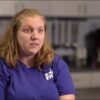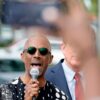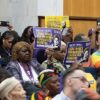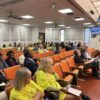July 27, 2008. The Richmond Times-Dispatch.
Free clinics and federally supported community health centers in the Richmond area need to add capacity to take care of an additional 1,000 patients annually for the next five years.
The recommendation is one of several in a report that outlines how the region can better meet the needs of low-income uninsured residents, who number about 57,000 — roughly 6 percent of the greater Richmond region’s 1 million residents.
“For free clinics, there are two main shifts in patient populations,” said John Baumann of the Fan Free Clinic in Richmond.
Rising health-care costs make health insurance more expensive and inaccessible, he said, causing the number of uninsured people to grow. Second, “we are seeing more . . . people coming to us for chronic-disease management — high blood pressure, diabetes, asthma.
“When you have increasing numbers of people unable to get health insurance or only able to get health insurance that they cannot afford — such as high-deductible, high-premium, high-co-pay policies — then all of a sudden you’ve got folks who need a medical home,” Baumann said.
According to the Census Bureau, the number of uninsured people in the United States grew 4.9 percent from 2005 to 2006 to 47 million, or 15.8 percent of the population.
The uninsured rate in Virginia is estimated to be about 13.2 percent. In the greater Richmond region, about 130,000 residents, or 13 percent of the population, are estimated to be without health insurance. Many people fall into the ranks of the uninsured when they lose jobs or become unable to afford insurance premiums.
. . .
Henrico County resident Patricia Bookman, 63, was laid off from her job in January 2007 and has been unable to find work since. Joel Price, 39, is unemployed and looking for work — he lost a landscaping job after back problems restricted what he could lift. Thomas Adih, 62, is self-employed, operating a home-based garment-printing business.
In the past year, Bookman, Price and Adih have had health problems — skin cancer, debilitating back pain and an enlarged prostate, respectively — requiring medical attention. None of the three has health insurance.
“Premiums shot out of my range,” Adih said. “To be self-employed, it’s hard to get reasonably priced insurance.”
All three tapped into the health safety net of free clinics, federally supported community health centers, hospital charity-care services and doctor-donated care. But as grateful as they are for the help they received, there also is the sense that they are fortunate. Others who are uninsured might not be so lucky or as persistent.
“I had no clue who to call,” Bookman said. She started with the Henrico County Health Department and after a series of calls was referred to Irvin Gammon Craig Health Center in Henrico. The center charges people based on their ability to pay.
“I am diabetic,” Bookman said. “They specialize in diabetes. I called them and got right in, no waiting or anything.”
Bookman’s second visit was a well-woman exam, which required her to put on a hospital gown. There was enough skin exposed that the nurse practitioner treating her was able to see the mole on her back. It didn’t look right. Subsequent tests determined it was melanoma, a potentially deadly skin cancer.
“They saved my life,” Bookman said. “It was caught early. If I hadn’t found this clinic, it probably would have gone to stage four.”
. . .
Reforming the way health care is paid for and provided, some say, will be a key issue for the next president.
“They have been promising us for three presidents,” Bookman said. “The government does not care. They have health insurance. All we get are promises.”
Baumann of the Fan Free Clinic is less inclined now than in some years past to write off the political discourse as election-year promises.
“We may have reason to have a little more hope than usual,” he said. “I think we are in a position where . . . it’s really becoming broader segments of society that are affected. I think that what we are seeing is there are many businesses, especially smaller businesses, that really want to be able to help their employees by providing health insurance that simply cannot afford to.”
The organization REACH, for Richmond Enhancing Access to Community Healthcare, published the report that recommends more capacity at free clinics and health centers. The study, called Bridging the Healthcare Gap, was one of the last major projects undertaken by the organization before it stopped operating this year. The organization’s board is discussing the agency’s next steps, including whether to restructure.
The report notes that there are about 20 organizations in the area that make up the health-care safety net, but care is sometimes fragmented and gaps in services exist.
“The system evolved from a lot of people trying to do the best they can to meet the needs of the growing numbers of uninsured people we are seeing,” said Baumann, who served on the committee that developed the report.
“The challenge has been how do we better coordinate all that we are doing.”
The REACH report makes recommendations focused on making the safety-net system of clinics, community health centers and other providers more accessible, accountable and efficient. The recommendations also include securing stable, long-term funding for safety-net providers and creating an overarching group, REACHplus, to oversee implementation of those goals, at an annual cost of $450,000.
. . .
The Rev. Ralph Hodge has seen the REACH report and thinks it is a good start. Hodge is chairman of the health-care committee of a grass-roots group called Richmonders Involved to Strengthen Our Communities.
“It really is a great plan, but when it was time to execute the plan, nobody did anything,” Hodge said.
“It puts a lot of pressure on the safety-net providers. All of those people have very limited resources,” he said. “The bigger players have to take a role in that. They’ve got to undergird many of those operations to make them viable, to handle the population of uninsured that is really out there. Who is going to take the mantle on that? That’s the big question.”
At a public community meeting in May, RISC singled out the VCU Health System to do more, primarily because of the amount of government funding VCU gets to take care of poor people.
RISC complained that VCU does not do enough to promote a program it offers called Virginia Coordinated Care. The program contracts with about 30 community-based doctors to take care of uninsured, low-income patients who might otherwise show up in the VCU emergency department, where care costs more to provide. The program is free for those who qualify for it.
“If you don’t know about a program, how do you find out about it?” Hodge said later during an interview. “There is absolutely no marketing of it.”
VCU officials bristled at the criticism and explained that government indigent-care dollars cannot be used to pay non-VCU doctors, so the health system funds the program out of revenue from other sources.
A breakdown by VCU officials shows that most of the $105 million in state and federal indigent-care dollars VCU received in 2006 paid for indigent hospitalizations (35 percent), surgery and trauma care (14 percent) and outpatient visits (13 percent). Other costs were for pharmacy, radiology, laboratory, emergency department and diagnostic services for indigent patients. VCU, according to state figures, is also the region’s biggest provider of charity care.
“We have put 19,000 uninsured Richmond residents in [Virginia Coordinated Care],” said Dr. Sheldon Retchin, VCU Health System chief executive officer, referring to the number of people enrolled.
“We have spent approximately $18 million of our bottom line, of the institution’s funds, that could be used for faculty salaries, for capital, for the dean. But we have done this, VCC,” Retchin said. He spoke in May at a joint meeting of the VCU board of visitors and the VCU Health System Authority board of directors.
. . .
When Brandi Ruff, 27, starts her job next month as a sign-language interpreter for the Chesterfield County school system, she will have health insurance.
“It’s really been frustrating to try to find a job that will provide insurance these days,” said Ruff, who is completing an associate’s degree in American Sign Language.
“My family helps me,” said Ruff, who recently had to come up with $315 to pay a bill at an urgent-care center she went to when sick. For routine care, she has relied on the Fan Free Clinic. She has been a patient on and off for five years as she changed jobs and her insurance situation changed.
“When it comes to their kindness and compassion and caring for people, they really go above and beyond,” Ruff said.
As much as she appreciates the free clinics, she says they cannot do it all.
“They rely on donations and things like that,” Ruff said.
The REACH report makes that point as well. According to a REACH survey, 41 percent of financial support for free clinics and community health centers is private philanthropy, such as donations from foundations, corporations and individuals. For free clinics alone, that percentage is 61 percent.
Thomas Adih first tried going directly to providers when he needed a prostate biopsy to see if he could self-pay and stretch out the payments.
“I tried negotiating, to set up a payment plan,” Adih said. “It would have cost $4,000. I tried to work with them. They said they would not be able to do it.”
Adih had attended a men’s health forum in February and kept the list of free clinics given out.
“One of them was Cross Over Ministry. I went there,” Adih said.
The staff at Cross Over did what they could for him and referred him to Access Now, a specialist-referral program that is housed at the Richmond Academy of Medicine and that REACH helped bring about. Adih was able to get a biopsy. He did not have cancer.
“Access Now is a lifesaver for me,” Adih said. “It’s like it gave me a whole new lease on life.”





